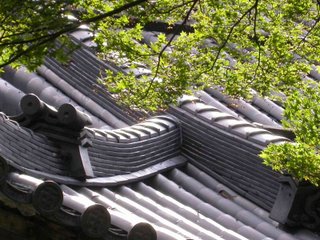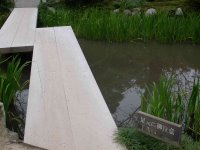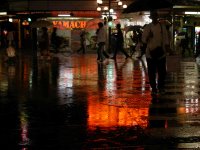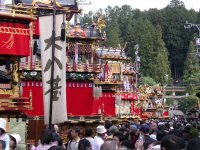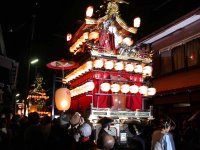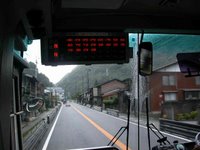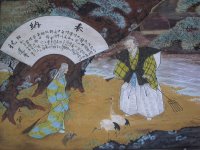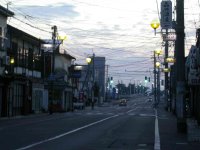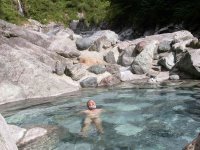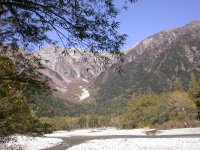 A
AI leave Basho in Ogaki with his friends, stay on the train to Nagoya, then continue on to Matsumoto by basu. Nagoya bus station is like any other bus station anywhere: open, draughty and seedy. The only difference is that, presumably due to lack of space, the stops are piled up one of top of the other, with my bus descending from the 4th floor by teleportation. An old drunk shuffles past. ‘realfake’ it says on his T-shirt.
I spend two days in Matsumoto, waiting for better weather, staying in the classically Japanese Momaru Ryokan on the river, visiting the castle. On my last evening I find a noodle bar, Matsumoto Ramen. I’m the only person in the bar at 7.30 PM. When the hell do they all eat? 2 in the morning? The waitress is friendly, but just stands by the till while I wolf my mayonnaise ramen soup with grilled chicken and sip my draught beer.
There’s a news item on the TV about a baby panda. She sighs. I say, “kawai ne?” (‘cute, innit?’). She smiles and comes over to talk to me (Talk? Well, mixture of Japanese, English, lots of charade). I tell her what I’m doing in Matsumoto, but she doesn’t recognise any of the names of mountains. ‘Not mountaineer,’ she says. She’s looking after the bar for her mother for a week, but she’s actually an aerobics teacher from Nagoya. I check – ‘ayulobics?’ "Hai!"
The door opens and a smartly-dressed young woman in a business suit comes in. ‘My sister!’ announces the waitress. I stand up to pay. Her sister does the honours. ‘Ah’, I say, ‘money woman!’’ No,’ says the sister, ‘no money!’ She says she works in insurance. ‘I knew it,’ I say – ‘money woman!’ The sister snorts and slaps me. The conversation turns to music. ‘Bayurcitylollers she likes,’ says little waitress sister pointing at smart big sister. ‘Huh? Oh – Bay City Rollers!’ Little sister giggles. ‘Velly old music!’ she says. We get onto the topic of past-it Lock Stars: ‘Slade!’ ‘Ah!’ ‘Sting!’ 'Nah!' 'David Bowie!’ I imply little sister is an old fogey, too. She slaps me. Hey, I’m being duffed up by two young Japanese women! More! I eventually erupt out of Matsumoto Ramen on waves of laughter and wander back to my ryokan giggling like a maniac.
On the 3rd day I get up at 5.30 AM and head for the early morning train on the Matsumoto-Dentetsu Line to Shin-shimashima, change to the bus, on to the Alps. The Japanese Alps did not exist in Basho’s day. They were created in 1888 by an American, Walter Weston. It seems a fitting end to my sojourn, to head for the hills. Basho would have approved. The ancients found the gods, wisdom, seclusion and consolation in the mountains (they didn’t mention being cold, scared and lost, but I’m sure they found that, too).
OKU-HOTAKA DAKE (3190M)
19 October 2005
 OK. Let's take a raincheck on this one. I'm nearly 9000 ft up in the Japanese Alps; on my own - last people I saw were heading down an hour ago; there's about 1/2 hour of daylight left; I've lost the track; and I'm stuck on a scree. Above me the cloud is swirling down and there's no sign of the supposed hut. Hmm. Perhaps I should've listened to the hut-girl at the Karasawa hut, now 800ft below...
OK. Let's take a raincheck on this one. I'm nearly 9000 ft up in the Japanese Alps; on my own - last people I saw were heading down an hour ago; there's about 1/2 hour of daylight left; I've lost the track; and I'm stuck on a scree. Above me the cloud is swirling down and there's no sign of the supposed hut. Hmm. Perhaps I should've listened to the hut-girl at the Karasawa hut, now 800ft below...I get to Karasawa at 14.40 after a beautiful 6 hour or so walk from Kamikochi (a high Alpine valley) via Yokoo-sa
 nso, now way down in the lower valley; first following the Asuza-gawa river, then branching off to the West to ascend ever more steeply. The trail is well-marked with white paint circles on rocks and trees. The first mark I see, a red 'O' with a yellow 'O' inside it, I think means 'no entry' or 'tree due for the chop', then decide it means 'do not smoke the trees'. That's alright then - I had no intention of doing so anyway. The hut-girl, who'd passed me twice at speed, once on her way down the mountain, once on her way back up again ("I just felt like going for a walk to the bridge!") tells me that it gets dark at 5pm and that I should stay the night at Karasawa, get up early the next morning for the summit of Hotaka, then go back down the same way,
nso, now way down in the lower valley; first following the Asuza-gawa river, then branching off to the West to ascend ever more steeply. The trail is well-marked with white paint circles on rocks and trees. The first mark I see, a red 'O' with a yellow 'O' inside it, I think means 'no entry' or 'tree due for the chop', then decide it means 'do not smoke the trees'. That's alright then - I had no intention of doing so anyway. The hut-girl, who'd passed me twice at speed, once on her way down the mountain, once on her way back up again ("I just felt like going for a walk to the bridge!") tells me that it gets dark at 5pm and that I should stay the night at Karasawa, get up early the next morning for the summit of Hotaka, then go back down the same way, 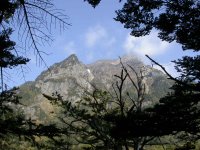 as it'd take me 2 1/2 hrs to get up to the Hotaka-dake-sanso hut. In any case, she says, the path over the peak then down the other side is not recommended. 'OK,' I think, and settle down in the hut.
as it'd take me 2 1/2 hrs to get up to the Hotaka-dake-sanso hut. In any case, she says, the path over the peak then down the other side is not recommended. 'OK,' I think, and settle down in the hut.5 minutes later the mountain jerks me to my feet. I tell the hut-girl I’m going on, and leave. What am I supposed to do for the next 1 3/4 hrs anyway? Look at her? Drink tea? If I don’t get up tonight it'll blow my schedule; I won’t get back down to Kamikochi before 4 or 5pm and not make Tokyo till very late. Then there's the 3rd or 4th Law of M
 ountain Walking which says: "Always gain as much height as you can when you can!" I forget the 1st, 2nd and 3rd ... probably one of them is: "Do not get yourself stuck on a bloody high mountain you don't know with dark falling and no trace of a path (!)". Another one certainly is: "If you have to cross a high mountain scree, keep those knees high and KEEP MOVING!" Except, of course, I can only make 5 or 10 yds before collapsing in exhaustion. Hmm...
ountain Walking which says: "Always gain as much height as you can when you can!" I forget the 1st, 2nd and 3rd ... probably one of them is: "Do not get yourself stuck on a bloody high mountain you don't know with dark falling and no trace of a path (!)". Another one certainly is: "If you have to cross a high mountain scree, keep those knees high and KEEP MOVING!" Except, of course, I can only make 5 or 10 yds before collapsing in exhaustion. Hmm...I suppose it sounds boastful to say I’m not afraid, but I’m not - well, only somewhere round the edges. Something inside is quite coolly calculating the percentages: 'let's see now, you just passed a ruddy big rock with a slight concavity on the downhill side - if you are forced to bivowak then you should survive in there with all your clothes on until it gets light enough to move again'; 'it's full moon tonight, the cloud should clear with dark falling, you'll be able to see enough even after dark to continu
 e on up'; 'that ridge to your right ... if you follow it down you'll hit the path at some point'; 'the sketch map in the guide shows the main path I'm supposed to join following the top of the ridge I'm most of the way up - so long as you go straight up you have to hit it at some point'.
e on up'; 'that ridge to your right ... if you follow it down you'll hit the path at some point'; 'the sketch map in the guide shows the main path I'm supposed to join following the top of the ridge I'm most of the way up - so long as you go straight up you have to hit it at some point'.Am I heading up for the right col at all? Well, I know I've got Hotaka on the left and some other peak on the right. I know I've got Karasawa immediately below. Also, the scree seems to be 'rounding off' not too far above me. I get my Indian Scout head-dress on and scour the scree for clues: a scrap of plastic sticks out between the rocks, a bit of rope ... 'ah ha - a piece of glass from a beer bottle!' Now, in general, the Japanese do not litter. I've seen none on the trail so far. So the fact that there are a few scraps here, and especially the beer bottle, would indicate a certain congregation of humans directly above. It might have been a will-o'-the wisp, but I also thought I heard a mechanical sort of noise way above my head some time ago, straight up. I decide to continue up to where the scree rounds off and see what I can see.
I get off the scree onto the ridge to my right, pull myself up on rocks and tough, wiry grass, panting, then have to cross it again to what looks like a slightly more stable area. Don't set the whole thing in motion, that would be a megazaster! Peaks rimmed in setting sun. Seemingly solid rocks shift, slide away under my feet. Rest every time I reach a seemingly solid bit, then scutter on to the next. Get to place where it flattens off a bit and poke my head over the top: right in front of me, Hotaka-dake-sanso, the hut.
Is it a mirage? I gasp up the last few metres of scree, clamber
 onto the wall and walk into the hut. The warden greets me and I register for the night. 7,300 yen with evening meal (about £37). An American, Scott, appears and greets me, too. Turns out he was an English teacher in Kyoto, saw an ad for a hut warden and got the job. Outside it's getting dark by the second, so I go and check the downtrail to see where the hell I got off it. Doesn't seem to be clear, though, whether it, in fact, hugs the ridge I scrambled up or actually goes down the scree. But I can't believe the couple I saw much much earlier could have got down the scree - if it started to go you'd slide along with a road of locks till you hit Davy Jones Rocker ... or the Karasawa Hut anyway, 1000ft below. I go round the back of the hut to look West, see if there are any dragons.
onto the wall and walk into the hut. The warden greets me and I register for the night. 7,300 yen with evening meal (about £37). An American, Scott, appears and greets me, too. Turns out he was an English teacher in Kyoto, saw an ad for a hut warden and got the job. Outside it's getting dark by the second, so I go and check the downtrail to see where the hell I got off it. Doesn't seem to be clear, though, whether it, in fact, hugs the ridge I scrambled up or actually goes down the scree. But I can't believe the couple I saw much much earlier could have got down the scree - if it started to go you'd slide along with a road of locks till you hit Davy Jones Rocker ... or the Karasawa Hut anyway, 1000ft below. I go round the back of the hut to look West, see if there are any dragons.The luminescent horizon is striated in bands of apricot, crystal, adamantine, chrysophagic chalcedony; merging into pumpkin, ortanique, deepest Muscat. And there are dragons. Their pimply snouts stick out above the sea of fluffy-wedding cloud, they bear the names Yari-dake, Tsurugi-dake, Onanji-yama...
I go in for dinner and join a Japanese couple at the table. Many, especially young, Japanese women have this very impulsive and playful demeanour. I rehydrate by sinking 10 cups of green tea, 4 of black and hang out in the library, which has a very nice collection of climbing and mountain walking books - and a gas heater. It was 6 degrees at Kamikochi and it's hovering around freezing up here. The hut is perched on a narrow col between Oku-hotaka-dake, 3190m (you get to call it the familiar 'Hotaka' once you've earned the right), and Karasawa-dake, 3110m, and, surprisingly, doesn't seem to get blown off by the icy blasts of winter or shrugged off by a twitch of the dragon's shoulder. It's got a heated toilet seat! Wow, I'm sitting on a heated toilet seat in a mountain hut at 3000m up in the Japanese Alps!
The hut guys have gone crazy outside and are dancing around with sparklers and fireworks. I ask Scott if there's something to celebrate and he says, nah, it's just the isolation and altitude. It sends them nuts. If it had gone dark before I got up, the flashes would've guided me in right on the nose... Scott says the hut's closing for the season next week, he's off back to the Useless States of Amerikee to work in a department store or something for the winter, then back in April to reopen the hut. It'll take me 8 hours to go over Hotaka and down the other side to Kamikochi, he says, so I'll need an early start. I'm lucky - they usually have snow by mid-September up here. I'd never have made it if there'd been any. I roll out my futon on the sleeping platform along with the other overnighters, note with approval that it's mixed sex, pull the thick quilt over myself and attempt to sleep.
DRINGGGGG! Or, actually, lack of DRINGGGGG! I'd set my alarm for exactly 4.59 and I wake up at exactly 4.58. 'Mountain calling, this is your morning call! Hey, Hotaka here! Wanna see the sunrise from my top? Then get your great hairy butt outta the sack and get yer boots on!'
Uh. Oh. Uff. I'd packed the night before, so within 10 minutes I say g
 oodbye to the hut, slide the door open and walk out into darkness with the faintest glimmering of light. The initial climb out of the col is more of a scramble, up freezing cold iron ladders, hanging onto chains, clutching rocks, but then eases off. The East is aglow in peach over a roil of cottonwool, the cloud layer being at least 1000ft below me. Peaks jut darkly out of the cloud-sea, one an active volcano with a black, wind-drifted plume of smoke parallel to the horizon. I round a shoulder of Hotaka and suddenly see, perfectly framed by the mountain and a slope: FUJI! Surely it must be? No other mountain is so high and so perfectly cone shaped... she beckons incandescently out of shifting opalescent lamella even Hokusai's deftness could never reprodu
oodbye to the hut, slide the door open and walk out into darkness with the faintest glimmering of light. The initial climb out of the col is more of a scramble, up freezing cold iron ladders, hanging onto chains, clutching rocks, but then eases off. The East is aglow in peach over a roil of cottonwool, the cloud layer being at least 1000ft below me. Peaks jut darkly out of the cloud-sea, one an active volcano with a black, wind-drifted plume of smoke parallel to the horizon. I round a shoulder of Hotaka and suddenly see, perfectly framed by the mountain and a slope: FUJI! Surely it must be? No other mountain is so high and so perfectly cone shaped... she beckons incandescently out of shifting opalescent lamella even Hokusai's deftness could never reprodu ce accurately.
ce accurately.To those who dareI hit the peak finally just after 6am, just as the sun explodes over the horizon. I'm the third highest man in Japan (presuming someone's up the 2nd highest, surely someone'll be up Fuji)! Totally on my own. Funny, in this oh-so-crowded archipelago I've nearly always been on my own. Sun
wholly unexpected treasure is granted:
Fuji-san from
Hotaka!
 rise at Oku-hotaka-dake, 3190m, 6.14 am, Thursday 20th October, 2005. A moment to treasure for the rest of my life.
rise at Oku-hotaka-dake, 3190m, 6.14 am, Thursday 20th October, 2005. A moment to treasure for the rest of my life.I take pictures then share the 'Gipfelwasser' with the mountain god (a can of sake I'd bought in Matsumoto). More a German custom? ('Gipfelwasser = 'peak water' ie a schluck of alcohol when you climb a peak): oblation on rocks in front of his shrine / cheers, old fellow! / mouthful for me / left rest for him. 2 Japanese guys from the hut are now climbing up to join me. I greet them, say 'Yaboo, sucks, you missed the sun
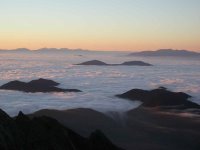 rise you lazy sons of guns you should've got up a bit earlier!' (well, play-act); they grin.
rise you lazy sons of guns you should've got up a bit earlier!' (well, play-act); they grin.I head off down to Mae-hotaka-dake to the SW, which is 300ft lower. It's a perfect day now, but I'm still grateful for the waymarkings - they add an 'X' to indicate 'NOT this way!'. The 'Daikiretto', which, according to the Lonely Planet 'Hiking in Japan' guide, is 'the most exhilarating (or the scariest) bit of hiking in Japan that does not require any specialist skills', is only a few miles north of where I am. It 'adds a skull and crossbones marking' to indicate that those who went that way went the way of all flesh... you 'drop from 3033m to 2748m at the bottom of the hole, then back up to 3106' and there are 'steel ladders, chains and BIG drops'.
I had been regretting not having 3 days to do this stretch a
 s well, but as the Lonely Planet guide seems to be written for Jaunty Young Things With a Spring in their Step and a Song in their Hearts who vault from rock to rock over death-defying precipices like mountain goats, yodelling at the same time, not for middle-aged slowpokes like moi, I am now glad I didn't bite of more than I can chew. Their classification system needs redrafting for oldies: 'easy' means 'middling'; 'n
s well, but as the Lonely Planet guide seems to be written for Jaunty Young Things With a Spring in their Step and a Song in their Hearts who vault from rock to rock over death-defying precipices like mountain goats, yodelling at the same time, not for middle-aged slowpokes like moi, I am now glad I didn't bite of more than I can chew. Their classification system needs redrafting for oldies: 'easy' means 'middling'; 'n ormal' means 'steep'; 'steep' means 'terrifying'; and 'exhilarating' means 'brown pants time'. I also consider recommending them to classify 'walks' as 'a one banana hike (1B)', two banana hike (2B)', 'three bananas' etc, judging by my rate of consumption. They'll probably conclude I'm a few bananas short of a bunch myself.
ormal' means 'steep'; 'steep' means 'terrifying'; and 'exhilarating' means 'brown pants time'. I also consider recommending them to classify 'walks' as 'a one banana hike (1B)', two banana hike (2B)', 'three bananas' etc, judging by my rate of consumption. They'll probably conclude I'm a few bananas short of a bunch myself.I reach, but do not ascend Mae-hotaka-dake (it'd take another 40 minutes and I'm worried about making an early bus from Kamikochi). The way ahead looks precipitous, but then I look back at what I've just come over, which looks even worse! Perhaps, as with so much of life, we project anxiety, whereas ‘just-doing-it’ naturally, automatically, leads on the the next step. Do people ‘with your best interests at heart’ or ‘trying to help you’, like the hut girl at Karasawa, actually help you? Moot point, arguable in all sorts of ways. My reaction is to distrust them and their advice, to avoid, side-step them, and do what the mountain, life, tells me. That way, perhaps, you're often 'wrong' but what the hell, Mabel... at least you know you're alive and it's solely your own stupid fault. The deal is, you make the decision, you live by the consequences. No moaning. That's a deal you make all the time, it's just more immediate and nearer in high mountains.
The
 trail turns West and drops. So this is what Lonely Planet considers 'steep'. It is, but there's no exposure and the rock is solid. Again, the too-steep bits have chains or iron ladders. The sun is gradually creeping into the Dake-sawa Valley in front of me, I can see the red-roofed Dake-sawa Hut crouched next to a dry river bed far below, then further, all the way down to Kamikochi, nestled alongside the skein of the Asuza-gawa river. The sun gradually flattens the world out from that crisp, new, early morning sharpness, jagged arete against pumpkin dawn, black shadows on skeletal trees. I stop to take pictures but my battery proclaims it's 'exhausted'. Well, so am I, mate, but I gotta get down this here mountain! I take it out and stick it in an inside pocket to warm up, upon which it allows me a few more pictures.
trail turns West and drops. So this is what Lonely Planet considers 'steep'. It is, but there's no exposure and the rock is solid. Again, the too-steep bits have chains or iron ladders. The sun is gradually creeping into the Dake-sawa Valley in front of me, I can see the red-roofed Dake-sawa Hut crouched next to a dry river bed far below, then further, all the way down to Kamikochi, nestled alongside the skein of the Asuza-gawa river. The sun gradually flattens the world out from that crisp, new, early morning sharpness, jagged arete against pumpkin dawn, black shadows on skeletal trees. I stop to take pictures but my battery proclaims it's 'exhausted'. Well, so am I, mate, but I gotta get down this here mountain! I take it out and stick it in an inside pocket to warm up, upon which it allows me a few more pictures.I sit on a rock and wait for 2 guys to chug slowly past on their way up. The first one sees me at the last minute and immediately strikes up a conversation in English. He's old, he says, 'not so fast anymore.' They spent the night at Dake-sawa and are heading up the way I've come, over Hotaka, down to the Karasawa Hut for that night. 'Old' or not, I'm impressed. Mr First-Friendly takes some pictures of me on my
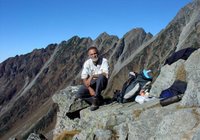 rock and promises to email them to me at home in England (see pic - thank you, Ken Matsumoto!). His companion gives me some spicy sweets. I have my second meal of the day (bread, blueberry jam, German sausage, squashed banana), rehydrate with hut water and continue the unremitting descent to the Dake-sawa Hut where I have the third meal of the day (bread, blueberry jam, German sausage, squashed banana). More of my front tooth breaks off. I nod to a lone Ozzie woman hiker with a massive backpack - she also spent the night at the Hotaka Hut, but in her tent on the heli-landing pad (! obviously a mere toddle for her, this 'walk'!). I recross the boulder-strewn river course and gradually wind down through moss-crept pine, cedar and cryptomeria forest to where the track gives onto a tourist trail along the limpid sidestreams of the Asuza-gawa. Here I turn left, but decide after 10 minutes it's wrong and ask some tourists. They say 'bus station right (nitwit)!' I retrace my steps and stagger down to the Kappa-bashi Bridge. You can scarcely see any water for the swarms of day-trippers, photographing each other in front of the sights, painting watercolours on the river beach, picknicking, buying souvenirs.
rock and promises to email them to me at home in England (see pic - thank you, Ken Matsumoto!). His companion gives me some spicy sweets. I have my second meal of the day (bread, blueberry jam, German sausage, squashed banana), rehydrate with hut water and continue the unremitting descent to the Dake-sawa Hut where I have the third meal of the day (bread, blueberry jam, German sausage, squashed banana). More of my front tooth breaks off. I nod to a lone Ozzie woman hiker with a massive backpack - she also spent the night at the Hotaka Hut, but in her tent on the heli-landing pad (! obviously a mere toddle for her, this 'walk'!). I recross the boulder-strewn river course and gradually wind down through moss-crept pine, cedar and cryptomeria forest to where the track gives onto a tourist trail along the limpid sidestreams of the Asuza-gawa. Here I turn left, but decide after 10 minutes it's wrong and ask some tourists. They say 'bus station right (nitwit)!' I retrace my steps and stagger down to the Kappa-bashi Bridge. You can scarcely see any water for the swarms of day-trippers, photographing each other in front of the sights, painting watercolours on the river beach, picknicking, buying souvenirs.I finally roll into the bus terminal at 12.40. It's taken me 7 1/2 hours from the Hotaka Hut, nearly the 8 Scott said. I book the next bus out (13.20), there’s the usual bus confusion but I eventually get on the right one which links to the train at Shin-shimashima and fall asleep.
Bus from Matsumoto and 5 ½ hours later hours later I'm disgorged onto the other-planetary streets of Tokyo beneath 55 floor superscrapers. I muddle my way via JR and the Yamanote Line to Ikebukuro and pitch up at the pre-booked Kimi Ryokan, a world away from the domain of the mountain gods.
Mike and Yoko take me to the site of Basho's old hut alongside the Sumidagawa (river) in the days when 'Tokyo' was called 'Edo' and was further to the West, around the 3 rivers which flow into Tokyo Bay. At the end I come to the beginning, where Bassho started out in the Spring of 1689.
After 16 hours flying, back in Bristolbug-eyed hyper-cruiser
takes Basho upriver
sunset water
Need to thrash my son at tennis
clean kitchen floor
hope my wife hasn't
found out she doesn't need meEND





